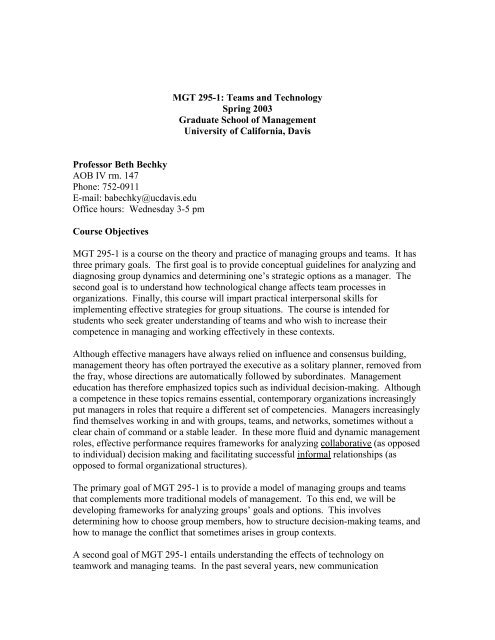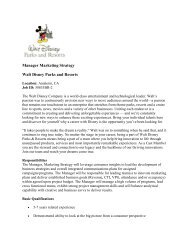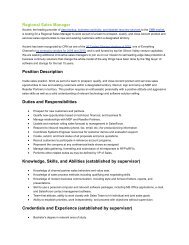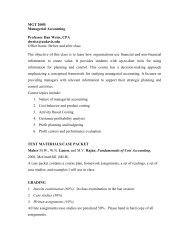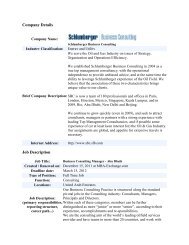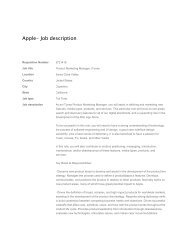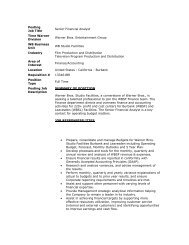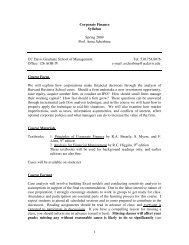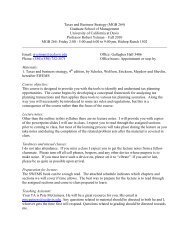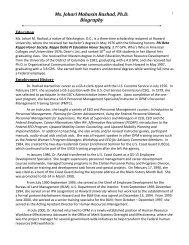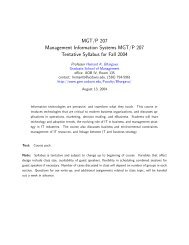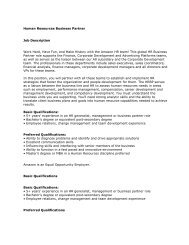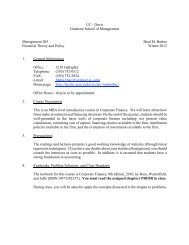MGT 295-1: Teams and Technology Spring 2003 ... - Students
MGT 295-1: Teams and Technology Spring 2003 ... - Students
MGT 295-1: Teams and Technology Spring 2003 ... - Students
You also want an ePaper? Increase the reach of your titles
YUMPU automatically turns print PDFs into web optimized ePapers that Google loves.
<strong>MGT</strong> <strong>295</strong>-1: <strong>Teams</strong> <strong>and</strong> <strong>Technology</strong><br />
<strong>Spring</strong> <strong>2003</strong><br />
Graduate School of Management<br />
University of California, Davis<br />
Professor Beth Bechky<br />
AOB IV rm. 147<br />
Phone: 752-0911<br />
E-mail: babechky@ucdavis.edu<br />
Office hours: Wednesday 3-5 pm<br />
Course Objectives<br />
<strong>MGT</strong> <strong>295</strong>-1 is a course on the theory <strong>and</strong> practice of managing groups <strong>and</strong> teams. It has<br />
three primary goals. The first goal is to provide conceptual guidelines for analyzing <strong>and</strong><br />
diagnosing group dynamics <strong>and</strong> determining one’s strategic options as a manager. The<br />
second goal is to underst<strong>and</strong> how technological change affects team processes in<br />
organizations. Finally, this course will impart practical interpersonal skills for<br />
implementing effective strategies for group situations. The course is intended for<br />
students who seek greater underst<strong>and</strong>ing of teams <strong>and</strong> who wish to increase their<br />
competence in managing <strong>and</strong> working effectively in these contexts.<br />
Although effective managers have always relied on influence <strong>and</strong> consensus building,<br />
management theory has often portrayed the executive as a solitary planner, removed from<br />
the fray, whose directions are automatically followed by subordinates. Management<br />
education has therefore emphasized topics such as individual decision-making. Although<br />
a competence in these topics remains essential, contemporary organizations increasingly<br />
put managers in roles that require a different set of competencies. Managers increasingly<br />
find themselves working in <strong>and</strong> with groups, teams, <strong>and</strong> networks, sometimes without a<br />
clear chain of comm<strong>and</strong> or a stable leader. In these more fluid <strong>and</strong> dynamic management<br />
roles, effective performance requires frameworks for analyzing collaborative (as opposed<br />
to individual) decision making <strong>and</strong> facilitating successful informal relationships (as<br />
opposed to formal organizational structures).<br />
The primary goal of <strong>MGT</strong> <strong>295</strong>-1 is to provide a model of managing groups <strong>and</strong> teams<br />
that complements more traditional models of management. To this end, we will be<br />
developing frameworks for analyzing groups’ goals <strong>and</strong> options. This involves<br />
determining how to choose group members, how to structure decision-making teams, <strong>and</strong><br />
how to manage the conflict that sometimes arises in group contexts.<br />
A second goal of <strong>MGT</strong> <strong>295</strong>-1 entails underst<strong>and</strong>ing the effects of technology on<br />
teamwork <strong>and</strong> managing teams. In the past several years, new communication
technologies have enabled new forms of working <strong>and</strong> organizing – virtual worlds that<br />
seem significantly different from traditional forms of doing business. However, at the<br />
core of these new forms are the people who use the technologies <strong>and</strong> the contexts in<br />
which they are using them. We will explore how teams, <strong>and</strong> their members, are<br />
influenced <strong>and</strong> constrained by such new technologies.<br />
Finally, the approach of the course is based on the belief that a conceptual underst<strong>and</strong>ing<br />
of optimal management strategies is of little use without the behavioral skills required to<br />
implement these strategies. To this end, I have designed <strong>MGT</strong> <strong>295</strong>-1 with an emphasis<br />
on cases <strong>and</strong> exercises that afford the opportunity to apply the concepts concretely. You<br />
will analyze cases that illustrate dynamic social interaction processes that can either<br />
facilitate or impede success. Furthermore, you will participate in several in-class<br />
exercises that simulate challenging problems, followed by class discussions of how your<br />
experiences reflect relevant theoretical constructs. These exercises are designed to<br />
provide a forum in which to hone one’s team skills <strong>and</strong> management abilities.<br />
Course Format<br />
The course is designed to provide you with a thorough underst<strong>and</strong>ing of the dynamics of<br />
team-based work settings <strong>and</strong> their effects on group performance. As a result, students<br />
will be assigned to groups in the second class that will exist throughout the quarter <strong>and</strong><br />
will provide a context for experiencing <strong>and</strong> learning about the effects of group<br />
membership first h<strong>and</strong>. Group discussion periods, written assignments, <strong>and</strong> activities will<br />
provide many opportunities for students to discuss, reflect on, <strong>and</strong> explain their group's<br />
functioning. In addition, each group will collaborate on both a meeting analysis <strong>and</strong> a<br />
final group project described below. The primary teaching method in this course is<br />
inductive, experiential, <strong>and</strong> case-based. Relatively little class time will be devoted to<br />
st<strong>and</strong>ard lectures.<br />
Required readings:<br />
Textbook:<br />
Course packet:<br />
Larson, C.E. & LaFasto, F.M.J. 1989. Teamwork: What must go<br />
right/what can go wrong. Newbury Park, CA: Sage. (Abbreviated<br />
LL throughout syllabus)<br />
The course packet will be available at Navins. (Abbreviated CP<br />
throughout syllabus)<br />
Grading:<br />
Class participation 20%<br />
Personal reflection memo 10%<br />
Group ORTF case analysis 10%<br />
Group meeting comparison paper 20%<br />
Final group project/presentation 40%<br />
2
(1) Class participation (20% of final grade):<br />
Class participation is an essential part of the learning process in this course. Note that<br />
attendance is critical on days when exercises are scheduled. If you cannot attend, make<br />
sure to notify me at least 24 hours in advance. Because individual differences in<br />
perspective are a crucial component of the course material, contributing your perspective<br />
in this class is necessary, not only for your own learning but also for that of your<br />
classmates. However, it is possible to distinguish comments that greatly contribute to a<br />
discussion from those that do not. Quality comments possess one or more of the<br />
following attributes:<br />
• They offer a different, unique, <strong>and</strong> relevant perspective on the issue.<br />
• They are timely; they contribute to moving the discussion <strong>and</strong> analysis forward.<br />
• They are constructive; they build on rather than dismiss previous comments.<br />
(2) Personal Reflection Memo (10% of final grade)<br />
As an individual, write a memo (no more than three double-spaced pages) describing (1)<br />
your most effective <strong>and</strong> (2) your most ineffective group experience. This memo should<br />
incorporate your own team experiences with theoretical insights from the readings.<br />
Therefore the memo should use concepts from the readings to explain on what<br />
dimensions you feel the group was effective or ineffective (e.g., performance relative to<br />
external st<strong>and</strong>ards, group satisfaction, individual growth, or organizational gains). Why<br />
was the effective group successful? What could have been done to make the ineffective<br />
group more successful?<br />
Due: April 9 th<br />
(3) Group ORTF Case Analysis (10% of final grade)<br />
As a group, write a 5-page (double-spaced) paper that answers the following questions:<br />
Given ORTF's composition <strong>and</strong> purpose, what should Williams expect at the first<br />
meeting? How should he prepare for that meeting, <strong>and</strong> how, specifically, should the first<br />
meeting be conducted? What, if any, discussion format or procedures should be<br />
implemented? Be sure to justify your answers using concepts from this week's readings.<br />
Due: April 23 rd<br />
(4) Group meeting comparison paper: (20% of final grade)<br />
You are to compare <strong>and</strong> contrast three forms of team meetings: face-to-face,<br />
teleconference or online meeting, <strong>and</strong> video meeting. This, of course, requires that your<br />
team meet in these three different forms over the course of the quarter. Analyze your<br />
group’s process <strong>and</strong> effectiveness using each of the forms, discuss any problems<br />
encountered, <strong>and</strong> relate these to the concepts, theory, <strong>and</strong> readings from the course.<br />
Some questions you might consider: How was conflict resolution different across the<br />
three forms? How did they differ in terms of your ability to underst<strong>and</strong> one another?<br />
Were there differences in the way you felt about the team process or one another? Your<br />
3
comparison should be 6-8 pages <strong>and</strong> you should come to class prepared to discuss it on<br />
May 21st.<br />
Due: May 21 st<br />
(4) Final group paper (25% of final grade)<br />
This project should be completed in your assigned groups (assignments will be given in<br />
class). Each group will choose a real group or working team (not a sports team!) to<br />
observe <strong>and</strong> analyze its performance using the concepts learned in the course. You<br />
should use personal interviews from several sources to obtain information for your<br />
analysis. An 8-10 page report on the findings of your assessment <strong>and</strong> your<br />
recommendations is due at the end of the semester. The report should contain an analysis<br />
of the group’s performance <strong>and</strong> effectiveness, any problems encountered, <strong>and</strong><br />
recommendations for improvements (a concrete action plan) using the concepts, theory,<br />
<strong>and</strong> readings from the course. Be sure to cite appropriately. I am happy to meet with you<br />
to discuss your paper topics.<br />
The paper will be evaluated on the following criteria:<br />
Theory/application: How well do you underst<strong>and</strong> <strong>and</strong> apply the concepts learned in the<br />
course <strong>and</strong> the readings?<br />
Analysis: How clear <strong>and</strong> insightful is your analysis of the group? How well do you<br />
integrate the theory to create a coherent <strong>and</strong> logical argument? How well do your<br />
recommendations correspond to the conclusions of your analysis? How “actionable” are<br />
your recommendations?<br />
Organization: How clearly written <strong>and</strong> organized is the paper? Be sure to check spelling<br />
<strong>and</strong> grammar.<br />
Peer evaluation: How do the other members of your group evaluate your contributions to<br />
the group’s performance? Evaluation forms will be distributed the last day of class (this<br />
evaluation will be factored into your class participation grade).<br />
Due: June 4 th<br />
(5) Final Group Presentation (15% of final grade)<br />
In class, as a group you will give a brief professional presentation recommending<br />
a concrete action plan for your working team based on your performance<br />
assessment.<br />
Due: June 4 th<br />
4
CLASS ASSIGNMENTS<br />
1 st Session: Introduction to teams <strong>and</strong> team building (Wednesday, April 2)<br />
Readings: LL: Introduction <strong>and</strong> Chapter 1<br />
In Class:<br />
Introduction to the course<br />
2 nd Session: Group Performance <strong>and</strong> Creativity (Wednesday, April 9)<br />
Readings: CP: HBS CASE: A note for analyzing work groups (Merit Case)<br />
Thompson, Leigh. (2000). Making the Team. Chapter 2. Prentice-<br />
Hall.<br />
LL: Chapters 2 & 3<br />
In Class:<br />
Case discussion: Merit Corporation<br />
How effective is the NPD group at the end of Part IV of the case?<br />
What factors contributed to its effectiveness? How did the<br />
effectiveness change at the end of Part V? What might account for<br />
these changes?<br />
Cardboard box <strong>and</strong> INSITE! Creativity Exercise<br />
H<strong>and</strong>out:<br />
Due:<br />
Team contract<br />
Personal reflection memo<br />
3 rd Session: Creativity <strong>and</strong> conflict (Wednesday, April 16)<br />
Readings: CP: Thompson, Leigh (2000) Making the Team. Chapter 8: Creativity.<br />
HBR CASE: Suzy Wetlaufer (1994) The team that wasn’t<br />
Whetton, D. <strong>and</strong> Cameron, C. (1995) Managing Conflict (Ch. 7) in<br />
Developing Management Skills, pp. 412-451.<br />
LL: Chapters 4, 5, & 6<br />
In class:<br />
Debrief of creativity exercise<br />
Case discussion: The team that wasn’t<br />
5
4 th Session: Managing Meetings <strong>and</strong> Information Sharing (Wednesday, April 23)<br />
Readings: CP: HBS CASE: The Overhead Reduction Task Force (ORTF)<br />
Whetton, D. <strong>and</strong> Cameron, C. (1995) Principles for managing<br />
meetings in Developing Management Skills, pp. 454-476.<br />
Cosier, R.A., & Schwenk, C.R. (1990). “Agreement <strong>and</strong> Thinking<br />
Alike: Ingredients for Poor Decisions,” Academy of Management<br />
Executive, Vol.4, No.1, 69-74.<br />
In class:<br />
Due:<br />
Case discussion: The Overhead Reduction Task Force<br />
Murder Mystery Exercise<br />
Group ORTF Case analysis<br />
5 th Session: Group Design (Wednesday, April 30)<br />
Readings: CP: Nahav<strong>and</strong>i, A. <strong>and</strong> Ar<strong>and</strong>a, E. 1994. Restructuring teams for the<br />
re-engineered organization, Academy of Management Executive,<br />
8, pp. 58-68.<br />
Hamilton, J. (1996) The new workplace, Business Week, April 29,<br />
pp.107-117<br />
LL: Chapters 7 & 8<br />
Words in Sentences Instructions (h<strong>and</strong>ed out last week)<br />
In class:<br />
H<strong>and</strong>out:<br />
Words in Sentences Production Exercise<br />
Leadership Assessment Questionnaire<br />
6 th Session: Leading in the Team Environment (Wednesday, May 7)<br />
Readings: CP: Huey, J. (1994) The new post heroic leadership, Fortune, February<br />
21, pp. 43-50.<br />
Walton, R. <strong>and</strong> Hackman, J.R. (1986) Groups under contrasting<br />
management strategies. Ch. 5 in Designing Effective Work<br />
Groups (Goodman P. <strong>and</strong> Associates, Eds). Jossey-Bass<br />
Publishers.<br />
Hirshhorn, L. (1991) Taking the learner role, Ch. 5 in Managing in<br />
the New Team Environment. Reading, MA: Addison Wesley.<br />
LL: Chapters 9 & 10<br />
In class:<br />
Tanagram Production Exercise<br />
6
7 th Session: Virtual <strong>Teams</strong>: Trust <strong>and</strong> Organizational Issues (Wednesday, May 14)<br />
Readings: CP: H<strong>and</strong>y, C. (1995) Trust <strong>and</strong> the Virtual Organization. Harvard<br />
Business Review, 73, 3, pp. 40-50.<br />
Orlikowski, W. (1993) “Learning from Notes: Organizational<br />
Issues in Groupware Implementation” Information Society, 9, 4,<br />
pp. 237-250.<br />
Davenport, T. <strong>and</strong> Pearlson, K. (1998). Two cheers for the virtual<br />
office. Sloan Management Review, 39, pp. 51-65.<br />
HBR Case: Maruca, R.F. (1998) How do you manage an off-site<br />
team?<br />
In class:<br />
Case discussion: How do you manage an off-site team?<br />
8 th Session: Intergroup Relations: Group Loyalty <strong>and</strong> Organizational Politics<br />
(Wednesday, May 21)<br />
Readings: CP: Auletta, K. The fall of Lehman Brothers. Part I: Power, greed<br />
<strong>and</strong> glory on Wall Street. The New York Times Magazine,<br />
February 17, 1985<br />
Auletta, K. The fall of Lehman Brothers: Part II: The Men, the<br />
Money, the Merger.” The New York Times Magazine, February<br />
24, 1985<br />
In class:<br />
H<strong>and</strong>out:<br />
Due:<br />
Presentation <strong>and</strong> discussion of group meeting comparisons<br />
Case discussion: Group conflict at Lehman Brothers<br />
Qualitative feedback exercise<br />
Group meeting comparison paper<br />
7
9 th Session: Building a team-based organization (Wednesday, May 28)<br />
Readings: CP: HBS CASE: TRW: The Gainesville Plant<br />
In class:<br />
Case discussion: Building a team-based organization: TRW<br />
This case involves the establishment of a team-based plant from<br />
the ground up. Five critical design decisions are made regarding<br />
(1) top management team composition, (2) task requirements, (3)<br />
reward structures, (4) leadership, <strong>and</strong> (5) training. What are the<br />
consequences of these decisions? Given what you now know<br />
about designing effective group work, how would you advise<br />
Freeman about what to do next?<br />
Qualitative Feedback exercise<br />
Final Session: Wrap-up (Wednesday, June 4)<br />
Readings:<br />
In class:<br />
Due:<br />
NONE!<br />
Group Project Final Presentations<br />
Final group paper<br />
8


